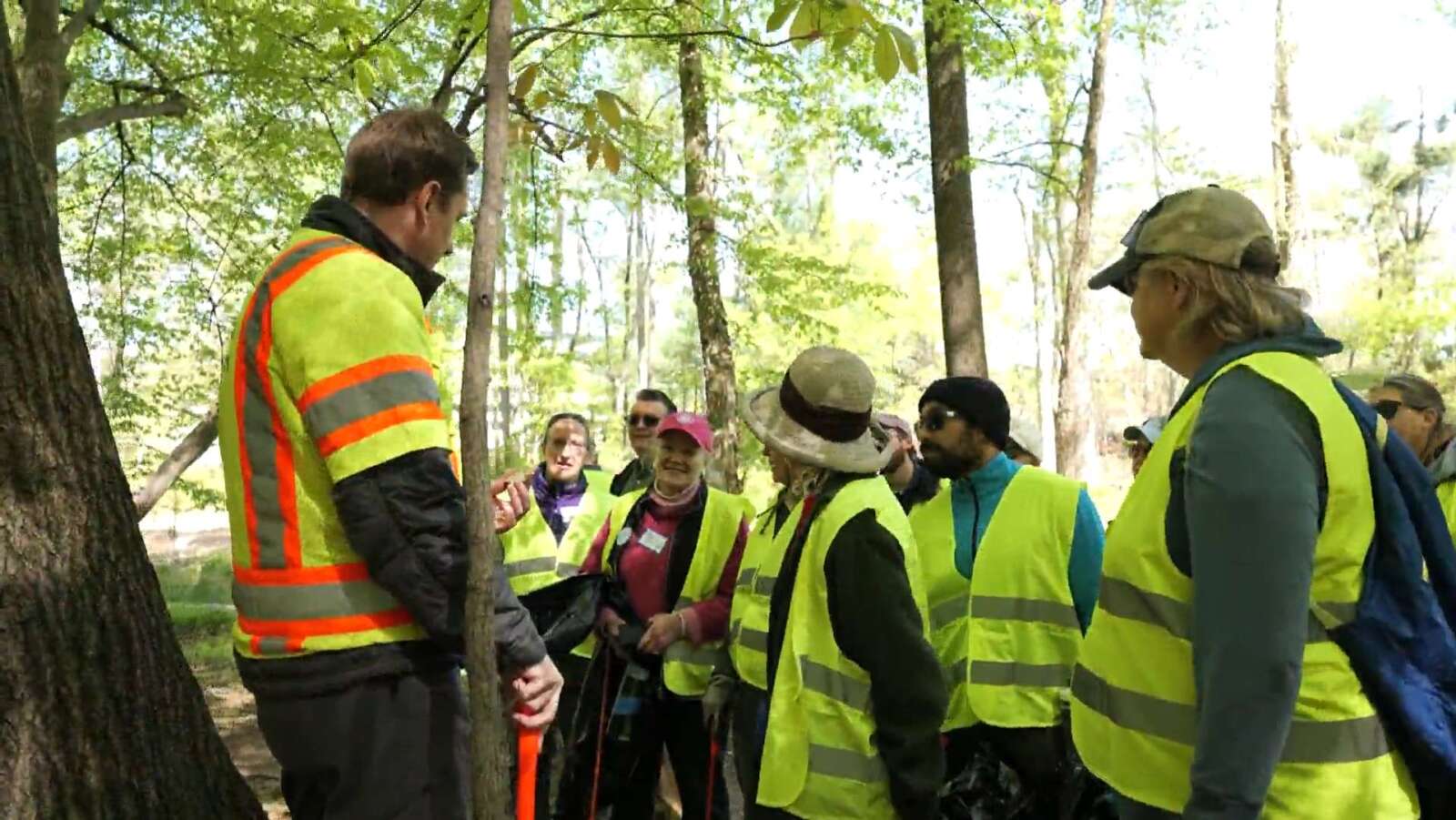
The continued development of Tysons doesn’t have to come at the expense of its remaining natural green space, argues a recent report on ways to preserve 65 acres of forest in the urban center.
A community task force has recommended two dozen actions that could help preserve and even enhance wooded areas collectively known as Tysons Forest, including tree plantings and clean-up efforts. Dated March 24, the report was formally accepted by the Fairfax County Board of Supervisors on April 16.
“Usually, task forces are not looking at preserving natural areas like this and enhancing them, but it was a really wonderful and very positive community-led effort,” Hunter Mill District Supervisor Walter Alcorn said at the board meeting.
Alcorn assembled the Tysons Forest Community Task Force last September to craft a plan for protecting the woods along Tysons’ southwestern edge. Spanning the Dulles Toll Road to Gosnell Road, the expanse includes the 33-acre Old Courthouse Spring Branch Stream Valley, the Ash Grove Historic Site and Raglan Road and Freedom Hill parks.
Chaired by resident Jack Russell, the task force counted residents, local building owners, office tenants, Fairfax County Park Authority staff and other county representatives, and conservation experts among its 23 members.
After meeting throughout the fall and winter, the group solidified recommendations that it hopes will enable humans and wildlife to coexist, while making Tysons Forest “sustainable and emerald green forever.”
Leading the proposals is the need for the county to officially recognize the stream valley corridor as Tysons Forest, including by adding wayfinding signage, and incorporate a pledge to protect the habitat in its Tysons Comprehensive Plan.
The task force also highlighted the importance of replenishing the area’s tree canopy, which it reported has declined by approximately 20-25% in the past five years. In addition to planting 200 wire-guarded trees and seedlings annually, the report suggests cutting down on the amount of invasive plants by at least 50% by 2028 and conducting counts of birds, bees and other wildlife to measure the area’s biodiversity.
Other notable recommendations include:
- Revive the Ashgrove Trail extension project and evaluate options for connecting it to the Vesper Trail south of Spring Hill Road
- Expand Tysons Forest by securing proffer contributions from developers and encouraging property owners to adopt ecologically friendly practices
- Maintain a safe and clean forest by requiring developers to mitigate run-off into streams, adding trash cans along walking trails and conducting regular trash cleanups
- Enlist local students as “green champions” by offering volunteer opportunities and including youth on future task force teams
- Create a website and events calendar for Tysons Forest
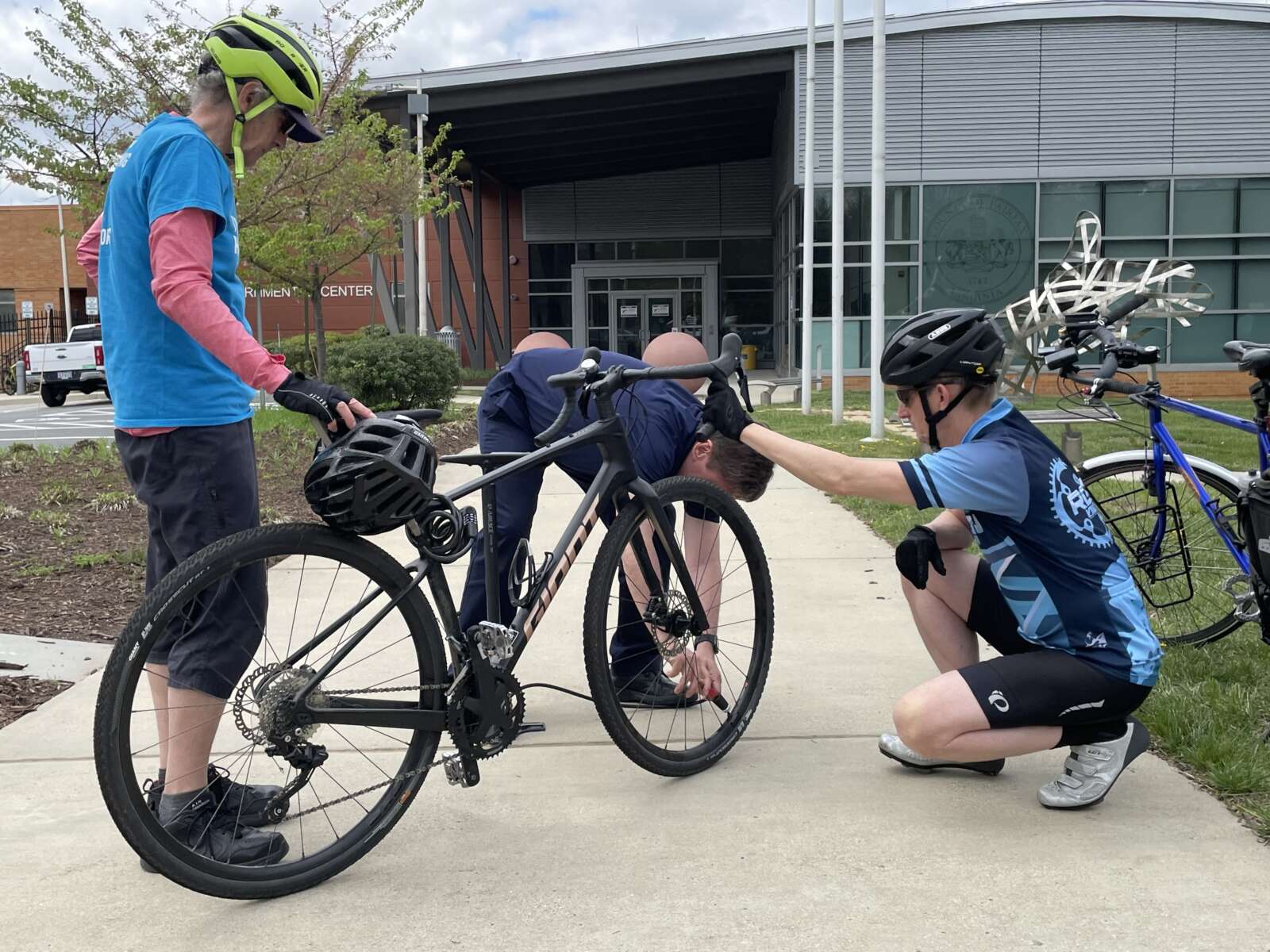
The annual Tour de Hunter Mill bicycle ride will kick into full gear early next month with new routes designed to show off sights and amenities throughout the district.
Registration is now open for the fourth iteration of the May 5 community bike ride, which was introduced in 2021 by Hunter Mill District Supervisor Walter Alcorn.
The event will feature two brand-new routes — one spanning 16 miles and the other covering 27 miles — that both begin and end at the North County Governmental Center (1801 Cameron Glen Drive) in Reston, with a rest stop at Meadowlark Botanical Gardens (9750 Meadowlark Gardens Court) in Wolf Trap.
This year’s routes will incorporate portions of the Washington & Old Dominion Trail and, for the first time, a new shared-use path along Route 7 (Leesburg Pike), according to Alcorn’s office.
The 10-foot-wide path is part of the Virginia Department of Transportation’s Route 7 widening, which is redesigning key intersections and adding a lane in each direction from Reston Avenue to Jarrett Valley Drive just outside of Tysons.
Though VDOT is targeting July 31 for completing the overall project, the trail is already functional enough for cyclists and pedestrians to use — at least between Reston Avenue and Towlston Road, according to Brian Worthy, a spokesperson for Alcorn’s office. A ribbon-cutting ceremony will be scheduled for late May.
“I’m excited that this year’s Tour de Hunter Mill will take advantage of the newest bike trail in the district — the new shared-used path along both sides of Leesburg Pike,” Alcorn said in a statement to FFXnow. “It will allow bikers to get from Reston all the way into Tysons safely, and it expands the transportation options for traveling safely along this busy corridor.”
Co-sponsored by the Fairfax Alliance for Better Bicycling (FABB), Reston Bike Club and Reston Community Center, the Tour de Hunter Mill costs $30 for adults, but children 15 and under can participate for free, as long as they’re accompanied by an adult.
The fee includes custom Tour de Hunter Mill socks for at least the first 165 registrants and a $5 donation to FABB, a volunteer, nonprofit organization that advocates for bicycling to be “safe, accessible and commonplace in Fairfax County for all ages, abilities and skill levels.”
The event will begin at 8 a.m. with riders checking in at a welcome table. After some opening remarks, the 27-mile ride will start at 8:30 a.m., and the shorter route will follow at 8:45 a.m. Once they finish, cyclists will be able to enjoy “food & fun” at the North County Governmental Center from 10 a.m. to noon, according to the registration page.
In a promotional video for the Tour de Hunter Mill, Reston Bike Club Vice Chairman Joel Kuester expressed hope that next year’s routes will utilize the new W&OD Trail bridge over Wiehle Avenue, which was installed earlier this month and is slated to open for use in June.
“Tour is a great way for folks to get out and experience the local roads, the trails and so on, so they know how to get around by bike,” FABB President Bruce Wright said in the video.
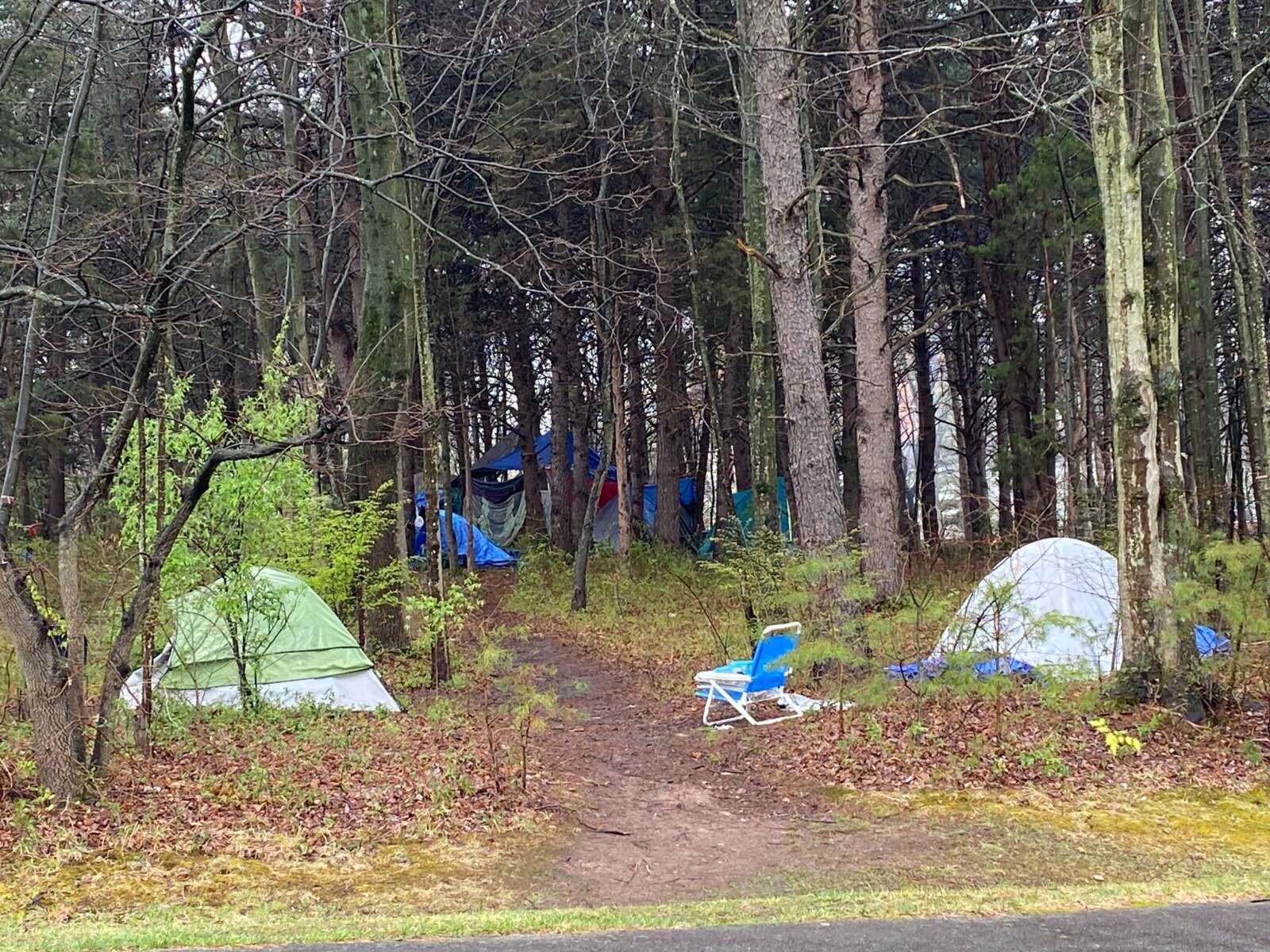
A tent encampment housing between 20 and 35 individuals in the woods between Inova’s emergency room and Sunrise Assisted Living Center in Reston may soon fold.
Fairfax County officials hope to open up a temporary overflow shelter in a government building in the Reston Town Center North area to accommodate the people who’ve been living in the tents.
“No Trespassing” signs are set to go up around the encampment, which is located on county property, in the coming weeks, as the county’s hypothermia shelters close their doors for the 2023-2024 winter season on Sunday (March 31).
The Reston encampment is the largest one in the county, according to Hunter Mill District Supervisor Walter Alcorn. Cornerstones — the nonprofit that runs Reston’s Embry Rucker Community Shelter — and its outreach teams plan to discuss their options with residents as the transition is phased in over the coming weeks.
“It’s really an unmanaged campground,” Alcorn said yesterday (Wednesday) in a call with media. “You know, if you walk through and talk to people, that’s really how its functioning at this point. So, I have concerns about, frankly, the safety of the folks living there now and the personal safety.”
Many details of the overflow shelter, including when it will open and how many people it can fit, remain to be determined, but it’s intended to help wind down activities in the encampment that has occupied the hill for years.
In some cases, neighbors have complained about the encampment, though data on how many police calls have been placed wasn’t immediately available.
According to Alcorn, there have been issues at the Reston Regional Library and reports of break-ins in some of the surrounding communities, but he cautioned that it would be “unfair” to attribute all incidents to the encampment.
Sunrise recently put up a fence around their property, creating a buffer between their property and the encampment.
Alcorn said he asked staff for an “effective and humane” plan for winding down the camp. He emphasized that its future is already in limbo because that property and the rest of Reston Town Center North are slated for major redevelopment. Plans call for a new Embry Rucker shelter and a new library, though an earlier agreement with a private developer fell through.
The encampment first began as a handful of tents but has since grown substantially. Reston Strong, a local nonprofit organization, began offering support to the area, providing food, tents and other supplies.
The organization launched a Neighbors in Tents campaign in 2022 to raise awareness about homelessness in Fairfax County. A temporary tent community was set up in front of the North County Governmental Center (1801 Cameron Glen Drive) as an alternative after the county’s hypothermia and COVID-19 emergency shelters closed for the season.
The organization called for permanent solutions to address homelessness in the county, which saw a 10% increase in people experiencing homelessness from 2022 to 2023. The results of the county’s most recent point-in-time count — an annual survey of the number of people without housing — are expected to be released in May.
Reston Strong says it welcomes the plans for a temporary overflow shelter to assist “our most vulnerable residents,” but it still has “many unaddressed concerns and questions.”
“We have not received answers from the county about when the shelter will be ready or if there is enough capacity for the Hill residents and those already in hypothermia, but we have been told via a letter from Supervisor Alcorn that no trespassing sign will be posted and we are not allowed to set up new tents,” Reston Strong organizer Sarah Selvaraj-Dsouza said. “The Hill will be closed in the near future for the planned land swap with Inova. We are hoping for a timely resolution that meets everyone’s needs.”
Alcorn said the logistics of the overflow shelter are still being ironed out.
News of a plan to clear the encampment comes as the county’s Redevelopment and Housing Authority prepares to implement a $20 million agreement that will provide housing for those in need, specifically individuals with serious mental illnesses.
Starting in May, the county will receive 300 new supportive rental assistance vouchers for residents over three years and three new staff positions to manage the program.
Alcorn says both initiatives are the beginning of important steps to addressing chronic homelessness.
“It’s going to make a big dent in the problem,” he said of the voucher program.
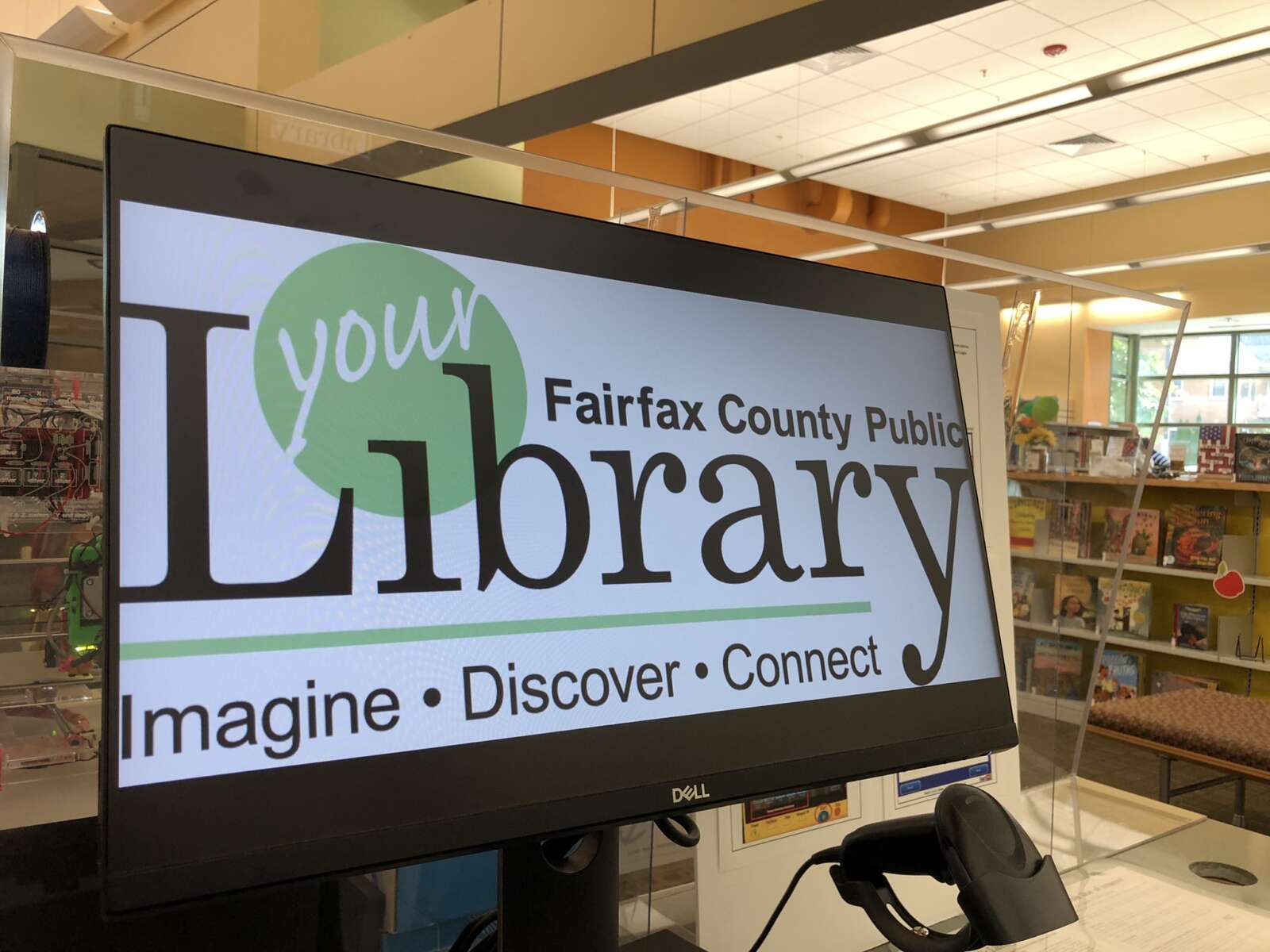
Fairfax County’s next budget could give its public libraries a little more spending money for books.
At the Board of Supervisors meeting on Tuesday (March 19), Hunter Mill District Supervisor Walter Alcorn proposed allocating an additional $500,000 in the upcoming fiscal year 2025 budget to Fairfax County Public Library’s book collection.
“The Library continues to be one of the most popular services provided by the county and our Library branches are a vital hub of community information,” Alcorn said in his board matter. “…We continue to face issues with meeting the demand for library materials even with the digital formats.”
County Executive Bryan Hill presented a proposed budget on Feb. 20 that increases FCPL’s funding by $410,027, partially offsetting a $1.2 million jump in personnel-related costs with cuts to the system’s operating expenses.
Planned reductions include eliminating a vacant management position, shifting to black-and-white public copiers instead of color ones, adjustments to the number of computers at each branch based on usage, taking over data storage from a third-party vendor and making FCPL’s quarterly magazine digital-only.
Overall, the county is budgeting just under $35 million in expenditures for the library system, most of which ($22 million) goes toward day-to-day operations at its 23 branches.
Alcorn noted that the county’s funding is supplemented by contributions from the nonprofit Fairfax Library Foundation and the Friends groups that support individual branches. The Friends of Reston Regional Library, for instance, donated $100,000 earlier this year to boost the children’s books collection county-wide.
However, funding for books and other materials remains inadequate “to meet the needs of our residents,” who sometimes have to wait months or even more than a year for popular items, he said.
With increased demand for popular and new materials, the Library must balance a proper allocation of limited resources for those items with the needs for materials in support of K-12 students, and ensuring that materials are updated, available in print, large print, audio and digital copies and in multiple languages. Additional funds to the collection budget will ensure that we are providing the resources our community demands from our Library and decrease the wait times so that people can access those resources in a timely fashion.
The Board of Supervisors agreed unanimously on Tuesday to add Alcorn’s proposal to its list of items to consider incorporating into the budget, which includes $3.83 million in not-yet-allocated funds.
Springfield District Supervisor Pat Herrity also asked county staff to find out why FCPL is only devoting about 10% of its budget to purchasing materials and whether that guidance comes from the county, the library’s Board of Trustees or the state.
“I think we do need to clearly invest in our library collections,” Herrity said. “It’s something our citizens like. It’s a basic public service we need to promote.”
Town hall meetings on the proposed budget are currently underway, with the Franconia District holding the next one at 6 p.m. today (Friday). Public hearings are scheduled for April 16-18, and the board will mark up the budget, including determining whether to add items like the library funding, on April 30.
A final FY 2025 budget will be adopted on May 7.
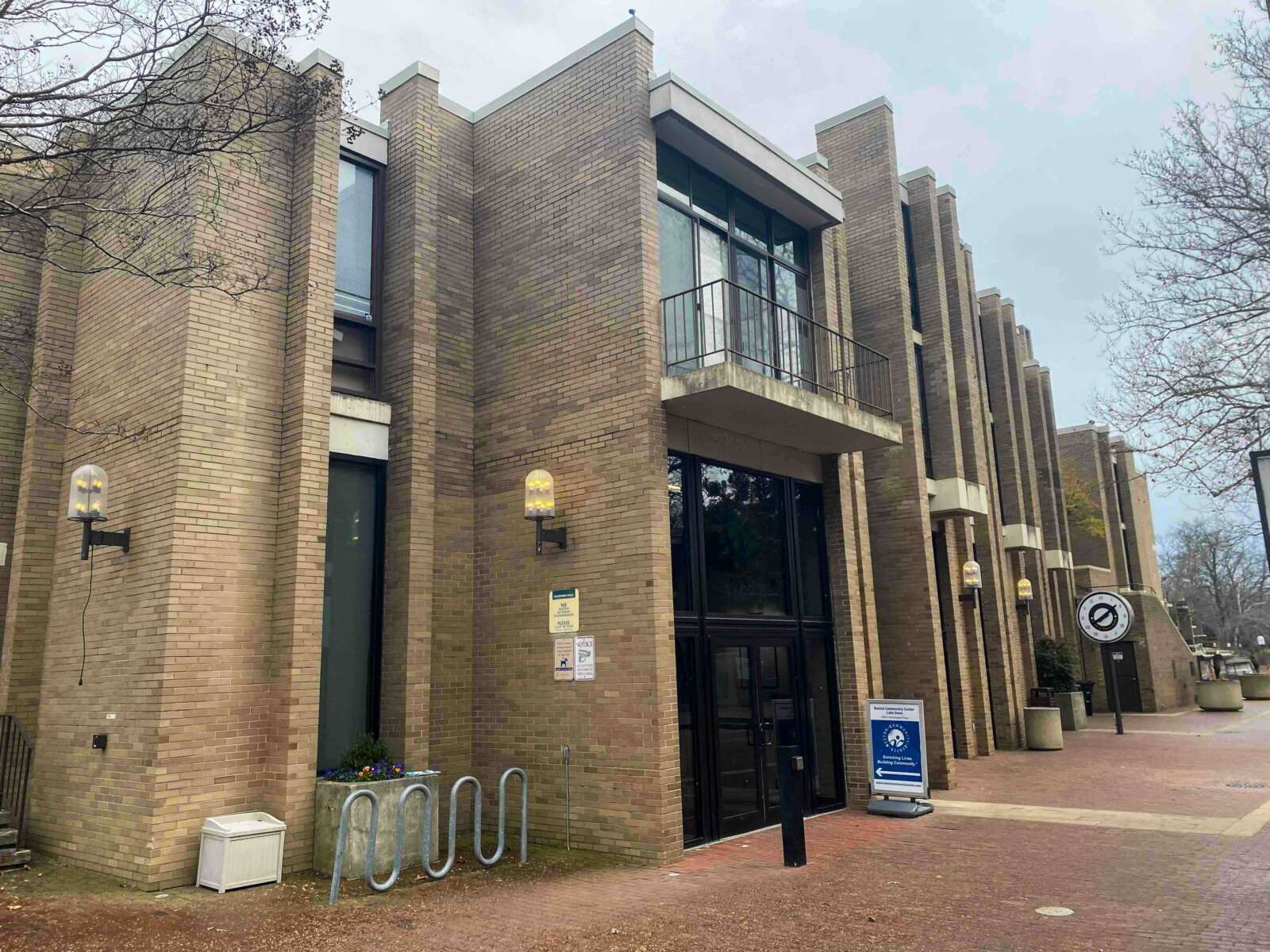
In the nearly 60 years since it was founded, Reston has become host to a variety of community and public entities with often blurred lines and responsibilities.
To provide clarity, Hunter Mill District Supervisor Walter Alcorn wants Fairfax County to develop an inventory of Reston’s community-level services and infrastructure, including who is responsible for what services and infrastructure and how they are funded.
The move was approved with no fanfare at a Fairfax County Board of Supervisors meeting today (Tuesday).
Alcorn said it is important to ensure that community-level services and infrastructure are sustainable.
“Last year, the Board of Supervisors approved the Reston Comprehensive Plan Amendment that will help guide our community growth into the future,” Alcorn said in the board matter. “With that process now completed, the next step is Plan implementation, and a review of Reston’s community-level services and infrastructure is an important step in Plan implementation.”
In some cases, organizations have assumed responsibilities above and beyond state requirements, such as cutting grass in and along Virginia Department of Transportation-owned streets, Alcorn noted.
Organizations that will be part of the inventory include Reston Community Center, Reston Association, Reston Town Center Association and the Reston Planning & Zoning Committee.
“As you can imagine, roles and responsibilities of these organizations are not intuitive to many residents, even for residents who have lived in Reston for decades,” Alcorn said, describing the collection of groups serving Reston as an “alphabet soup.”
Below is the full directive from Alcorn, which was unanimously supported by the rest of the board.
Board Matter
Hunter Mill District Supervisor Walter Alcorn
March 19, 2024Inventory of Reston Community-Level Services and Infrastructure
Background:
As our community approaches the 60th anniversary of the founding of Reston, the time is right to take stock of the community infrastructure that by many accounts, including a recent article in The Economist, has created a very successful community within Fairfax County. Reston currently has several important community organizations that are dedicated to creating a cohesive community experience. These organizations perform essential community-level services such as maintaining the trails and open space, providing camps for our kids, operating recreation facilities of all types, and hosting places for the community to gather. And in some cases, these organizations have assumed additional responsibilities as the Commonwealth of Virginia has devolved some of their responsibilities such as keeping the grass cut in and along VDOT rights of way.These organizations now form a veritable alphabet soup in Reston – nonprofits like RA, RTCA, the YMCA, and county operations like RCC, FCPA, and NCS. And this does not even include advocacy and advisory groups like RCA, Reston P&Z, and the CHCCAC. As you can imagine, roles and responsibilities of these organizations are not intuitive to many residents, even for residents who have lived in Reston for decades.
For Reston to be the success the next 60 years it has been in its first 60, these community-level services and infrastructure must be sustainable – including financially. Last year, the Board of Supervisors approved the Reston Comprehensive Plan Amendment that will help guide our community growth into the future. With that process now completed, the next step is Plan implementation, and a review of Reston’s community-level services and infrastructure is an important step in Plan implementation.
Motion:
Therefore, I move that the Board of Supervisors direct the County Executive’s office to coordinate with the Hunter Mill District office to develop an inventory of Reston community-level services and infrastructure including those noted above, and to include who is responsible for those services and infrastructure, and how they are funded.
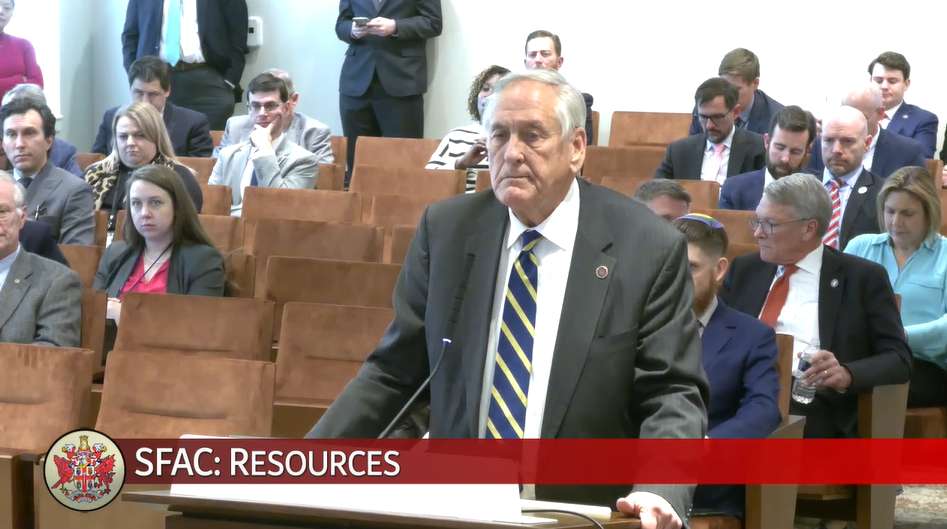
(Updated at 11:30 a.m. on 2/2/2024) The push to allow a casino in Fairfax County has stalled — at least for 2024.
A Virginia Senate subcommittee voted this afternoon (Thursday) to “continue” Senate Bill 675 until next year so a more in-depth analysis of the potential casino can be conducted.
The postponement came despite apparent support for the proposal by Sen. L. Louise Lucas (D-18), who chairs the Senate Finance & Appropriations resources subcommittee and quipped that she’s been called “the casino queen” during the meeting.
Sen. Dave Marsden (D-35), who patroned the bill that would make Fairfax County — specifically Tysons — eligible for a casino, previously told FFXnow that he was hopeful it would pass, noting that Lucas, who also chairs the overall finance committee, “likes [the] bill.”
However, some senators, led by Creigh Deeds (D-11), questioned whether the county had been sufficiently studied as a possible host locality. Tyler Williams, a subcommittee staffer, confirmed that the Joint Legislative Audit & Review Commission looked at Northern Virginia as part of a casino gaming study in 2019, but Fairfax County wasn’t being considered individually at the time.
The study estimated that a Northern Virginia casino would employ 3,200 workers and bring in an additional $155 million in tax revenue to the state, including about $100 million that Virginia residents are currently spending at out-of-state casinos, such as MGM National Harbor in Maryland.
“I would like to see some updated projections, because I would like to keep this bill alive,” Lucas said before the subcommitte voted.
Marsden first introduced legislation that would allow a casino along the Silver Line last year, but the bill was quickly withdrawn to allow for more research. Patch reported in September that the proposal would be revived during the 2024 General Assembly session, with developer Comstock targeting the Wiehle-Reston East Metro station area as a possible site.
However, after Reston Association and other community groups began to marshal opposition to the impending legislation, Marsden filed a bill on Jan. 17 with criteria that narrowed the potential locations to Tysons. The bill advanced to the Senate Finance and Appropriations Committee from a general laws committee on Jan. 24.
Marsden has argued that a casino could give Fairfax County a new source of tax revenue with the office market in flux, and he maintained at today’s meeting that the bill is intended to give the county the authority to make its own decision. If the bill eventually becomes law, a voter referendum would still be required to authorize a casino.
“I think it’s time to send this to the local government [to] make their own decisions about this. There’s plenty of local control here,” Marsden said.
The Fairfax County Board of Supervisors hasn’t adopted an official stance on the legislation, but members made their reservations clear in a legislative committee meeting last Friday (Jan. 26) and in a letter that Chairman Jeff McKay sent to General Assembly leaders.
In addition to questioning whether the county would actually reap the revenue benefits touted by casino proponents, the supervisors stressed that they hadn’t requested the authority for an establishment and hadn’t been consulted by Marsden or the prospective developers.
According to Marsden, Comstock’s vision includes a conference center, arts venue and hotel, along with a casino.
Hunter Mill District Supervisor Walter Alcorn told the resources subcommittee that he’s “a strong no” on the possibility of a Fairfax County casino. Vienna Mayor Linda Colbert and Herndon Town Councilmember Naila Alam also stated that they oppose SB 675.
“I’m very happy that the subcommittee members listened to the community and the people elected to represent them,” Alcorn said in a statement, thanking Colbert and Alam for joining him in testifying. “It is a big victory for everyone who cares about good government!”
Marsden says he’s “disappointed” by the outcome, while that the vote still keeps the bill alive until 2025.
“No one has any other ideas to give Fairfax County a brighter revenue future,” he told FFXnow.
Board of Supervisors Chairman Jeff McKay praised the resources subcommittee’s vote as “the right thing” to do, hopefully enabling the community to learn more about the proposed casino project.
The Senate finance committee will formally vote on whether to accept the subcommittee’s recommendation next Tuesday (Feb. 6).
“We only learned many of those details in dribbles as the bill was sorted out and after it was introduced, and we still do not have all of the information we need,” McKay told FFXnow. “The community deserves to know all the details of a major proposal like this, details such as what is actually included in the proposal, the proposed site, potential revenues, community impacts, traffic impacts, and more, before the General Assembly considers it.”
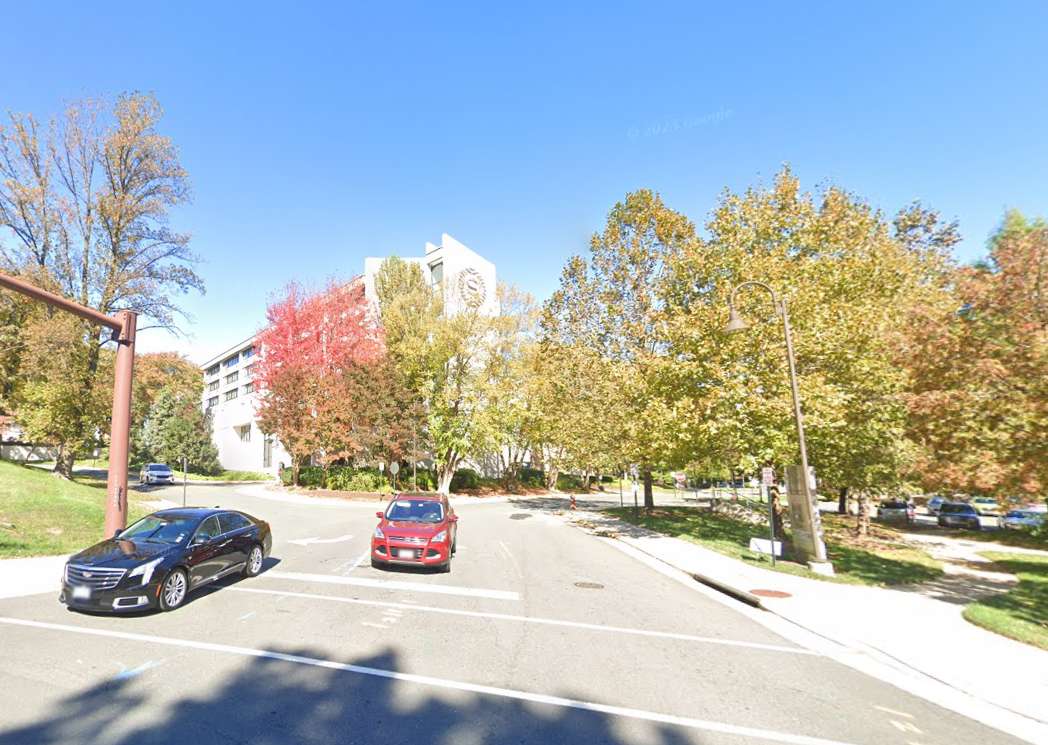
Missing pedestrian links along Sunrise Valley Drive in Reston may soon be filled following the acquisition of land.
The Fairfax County Board of Supervisors formally accepted land at 11810 Sunrise Valley Drive from developer JBG Smith, which owns the Sheraton hotel there.
The acquisition will allow the county to complete a 10-foot-wide walkway from Reston Parkway to Soapstone Drive.
The gift comes after JBG Smith — which owns one of the parcels affected by the walkway — declined to grant limited land rights to construct the project. The company instead asked the county to take ownership of the parcel in its entirety, according to a board matter introduced by Hunter Mill District Supervisor Walter Alcorn on yesterday (Tuesday).
“Acceptance of this small parcel would allow the county to avoid condemnation to complete the Sunrise Valley Drive pedestrian enhancements and would provide the county with land to make one or more small improvements on this open space in the future,” Alcorn wrote in the board matter.
County staff have previously said construction is expected to begin this winter on the project, which will improve existing walkways and install missing links along 1,500 linear feet on the north side of Sunrise Valley Drive.
According to the the board’s transportation priorities plan, roughly $8.8 million has been recommended over six years to install separated bicycle lanes and pedestrian facilities on the north side of Sunrise Valley Drive.
Image via Google Maps
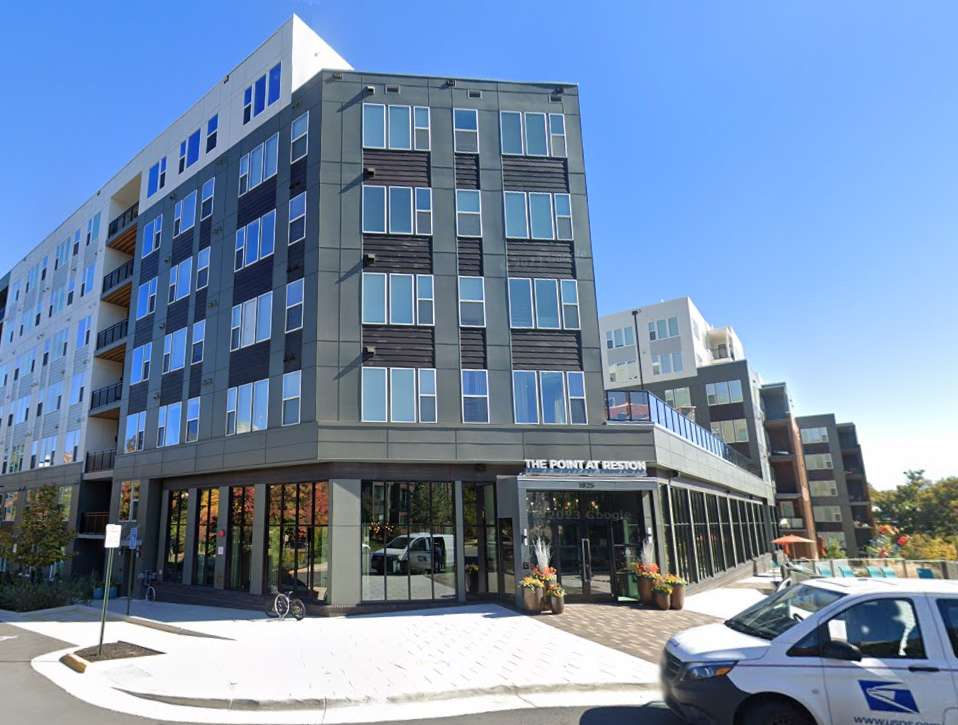
The Hunter Mill District is on track to meet the affordable housing goal set by Hunter Mill District Supervisor Walter Alcorn in March of 2022.
The district, which includes Reston and the Vienna area, has made “some good strides” toward Alcorn’s goal of adding 1,000 affordable housing units by 2027, the supervisor said.
“Currently there are more than 600 affordable units either recently constructed, under construction or scheduled to be constructed soon,” Alcorn said. “This is in addition to the several hundred existing units that are being preserved.”
At the same March 2022 meeting, the Fairfax County Board of Supervisors agreed to double its affordable housing goal by 2034.
Chairman Jeff McKay and Dranesville District Supervisor John Foust introduced a joint motion to set a goal of 10,000 net new affordable units by 2034 and ramp up the county’s resources to reach that goal. Springfield Supervisor Pat Herrity cast the lone vote against the proposal.
As of April 2022, the county had 15,483 committed affordable homes, meaning they’re restricted to designated income levels. Mason District had the most units, followed by Hunter Mill, whose projects have included The Point at Reston and, most recently, The Exchange at Spring Hill Station now under construction in Tysons.
Image via Google Maps
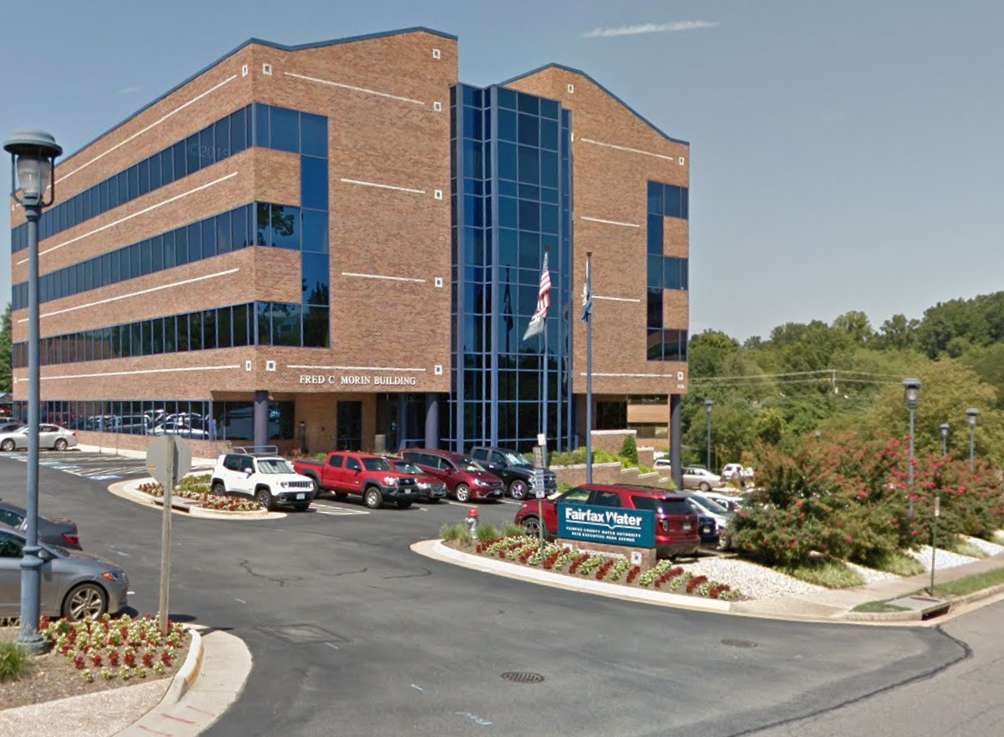
The new year may bring changes to how water is provided in and around the Town of Vienna.
The Fairfax County Board of Supervisors authorized staff on Dec. 5 to begin discussions with the town and Fairfax Water about the future of public water delivery service in areas currently served by Vienna Water.
Joined by Providence District Supervisor Dalia Palchik, Hunter Mill District Supervisor Walter Alcorn says he initiated the request for “a more in-depth discussion” in response to concerns about the discrepancy in rates from residents who live in the county but get water service from the town — which describes about a third of Vienna Water’s nearly 5,600 customers.
“This is a little bit of a hole in the donut for Fairfax Water,” Alcorn told FFXnow. “…Their water rates are significantly lower than Vienna Water’s, and Vienna Water, basically, it’s an older system, and what I’m interested in is a win-win possibility for Vienna Water to somehow work even more closely with Fairfax Water, if not be absorbed by Fairfax Water.”
The largest water utility in Virginia, Fairfax Water provides drinking water to nearly 2 million people, including residents of Fairfax County, the town of Herndon and the cities of Fairfax and Falls Church.
The two cities joined the system in 2013 and 2014, respectively, after years of resistance that included a federal lawsuit accusing Fairfax County of trying to monopolize the region’s water supply. The Town of Vienna was also part of that lawsuit, ultimately agreeing to purchase water from Fairfax Water while continuing to maintain its own system.
Even though the water it provides comes from Fairfax Water, Vienna Water charges a higher rate, starting at $6.40 per 1,000 gallons, compared to $3.65 per 1,000 gallons for Fairfax Water.
As of Dec. 1, Fairfax Water’s base water service charge of $80.65 is lower than all other D.C. area jurisdictions except for Herndon, which charges $75.03. Fairfax Water has proposed an increase to $84.72, starting on July 1, 2024, but that would still be lower than other localities, including the Town of Vienna, which charges $136.35.
“I’ve heard the most [complaints] from constituents that are Vienna Water customers who live in the Hunter Mill District but outside of the town boundaries,” Alcorn said, noting that Vienna Water’s service area also includes some Providence District residents. “They have asked me to look into this.”
It remains to be seen whether this discussion will go more smoothly than the ones the county had with Fairfax City and Falls Church. A Fairfax County Circuit Court judge ruled in 2010 that Falls Church’s water rates amounted to an “unconstitutional tax on county residents,” according to a 2011 Washington Post story detailing the then-ongoing clash between the county and city.
Vienna Finance Director Marion Serfass says the Town gets “occasional complaints from residents about water rates, but there is not a large volume of them.”
“More often they appreciate the prompt customer service they get from Vienna,” Serfass said.
According to Serfass, the town has budgeted $4.4 million to support its water system for the current fiscal year, which started on July 1 and ends June 30, 2024. That includes $2 million to buy water wholesale from Fairfax Water.
Another $1.5 to $1.7 million is spent annually on capital improvements for the water system, which includes 131 miles of distribution piping maintained by the town’s Department of Public Works.
If Fairfax Water takes over Vienna Water like it did with Fairfax and Falls Church, it would assume the responsibility of maintaining that infrastructure, but Alcorn emphasized that he’s not advocating for that approach just yet.
“[It’s] too early to say if that’s the outcome or not, but that’s why we need to have the staff-to-staff discussion,” Alcorn said.
The Board of Supervisors directed staff to provide an update on the Vienna Water discussions by this summer.
Image via Google Maps
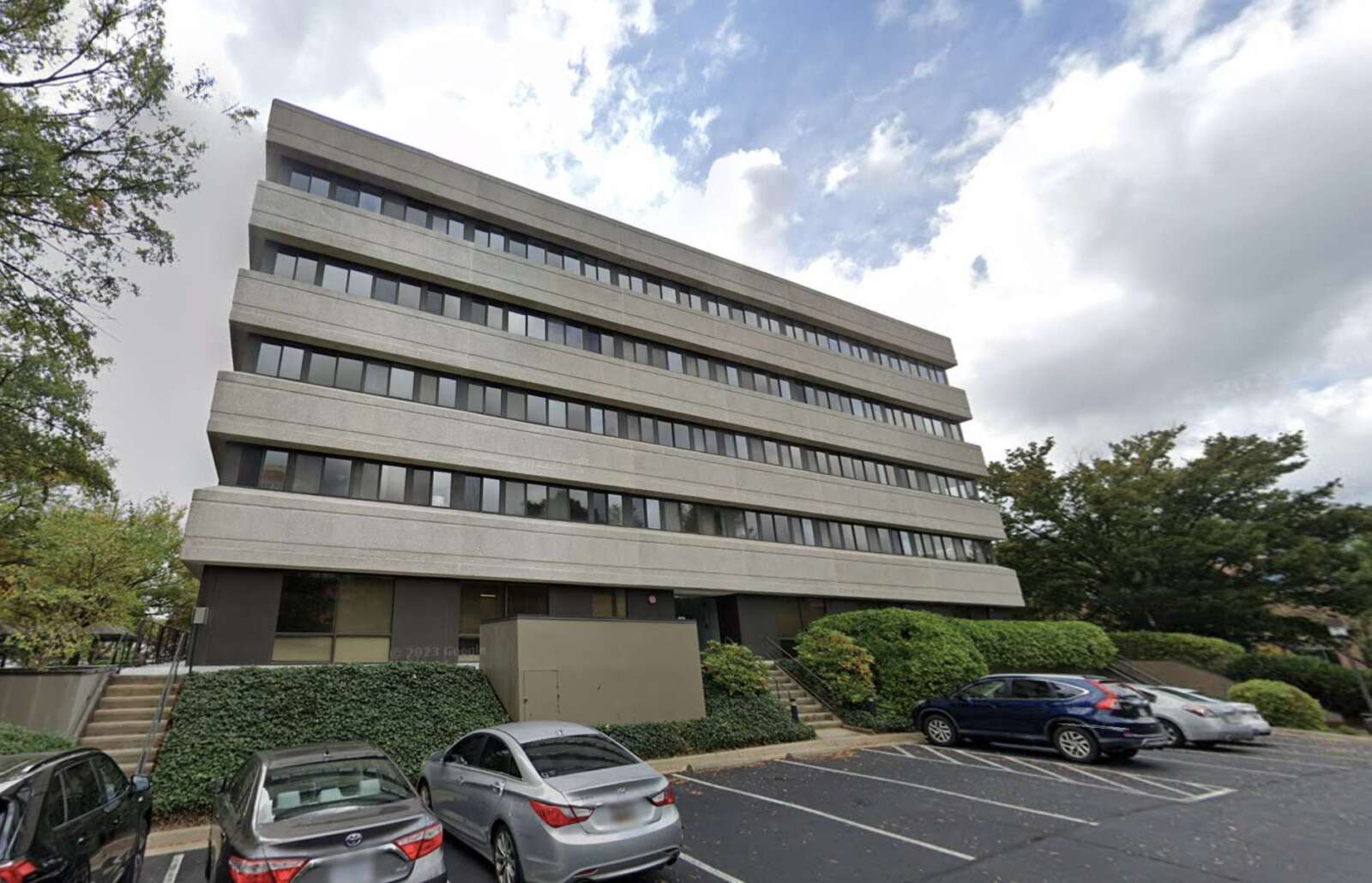
Housing could be on the horizon for Roger Bacon Drive in Reston.
At a meeting on Tuesday (Dec. 5), the Fairfax County Board of Supervisors unanimously approved a motion to initiate a review of a development proposal for 11260 Roger Bacon Drive, adding it to the county’s existing Comprehensive Plan Amendment Work Program.
The proposal would add the option of residential mixed-use development at the site, which is currently developed with a five-story office building that was constructed in 1980. Existing tenants of the building, which is across the street from a McDonald’s, include FVC Bank.
The preliminary plan pitches roughly 275 units and 3,000 square feet of ground-floor retail.
Hunter Mill District Supervisor Walter Alcorn said that if the proposal moves forward, a “coordinated analysis” would be necessary to ensure that the project is in harmony with neighboring areas.
“The addition of this plan amendment to the work program was coordinated with staff and it did not raise issues with staff resources,” Alcorn said.
The county’s comprehensive plan currently envisions a pedestrian-oriented environment with mid and-high-rise buildings and a mix of uses, including ground-floor retail. Parcels on Roger Bacon Drive are developed with office buildings, a 23-unit condominium building and three restaurants, along with surface parking.
The potential amendment would also include a planned grid of streets linking Roger Bacon Drive, Michael Faraday Court, and Lake Fairfax Business Center.
Alcorn also asked the county to remove a proposal by Brookfield Properties from the work program. The developer had requested an increase in the amount of housing allowed around the Sunset Hills Road and Hunter Mill Road intersection.
The nomination, which also suggested the possibility of retail, was one of several Reston-related proposals accepted by the county board in April as part of its Site-Specific Plan Amendment (SSPA) process, which allows particular properties to be submitted for land use changes.
Many of the Reston nominations were prioritized for review in an overall study of the Reston Transit Station Area, but the Brookfield proposal had already been deferred in the lowest, third tier of the work program.
“Review of this area could be considered during the next Site-Specific Plan Amendment nomination period if a nomination is received at that time,” Alcorn’s board matter said.
The SSPA process kicked off in October 2022. Nominations for site-specific evaluations were accepted following a screening phase in December last year.
Image via Google Maps

